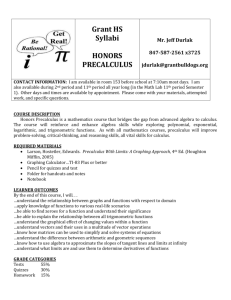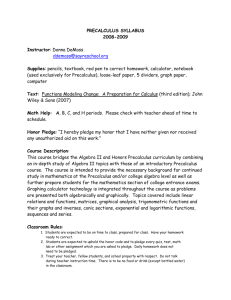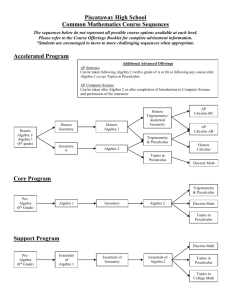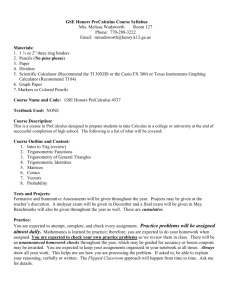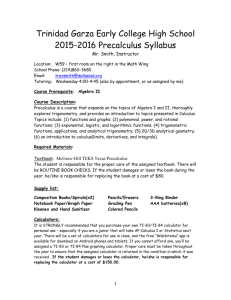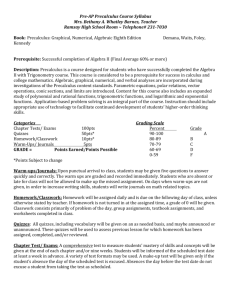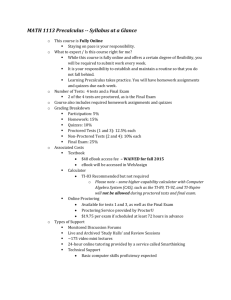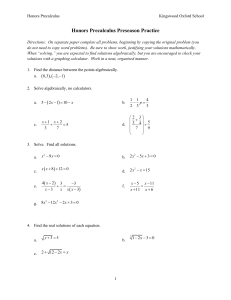Algebra 3
advertisement
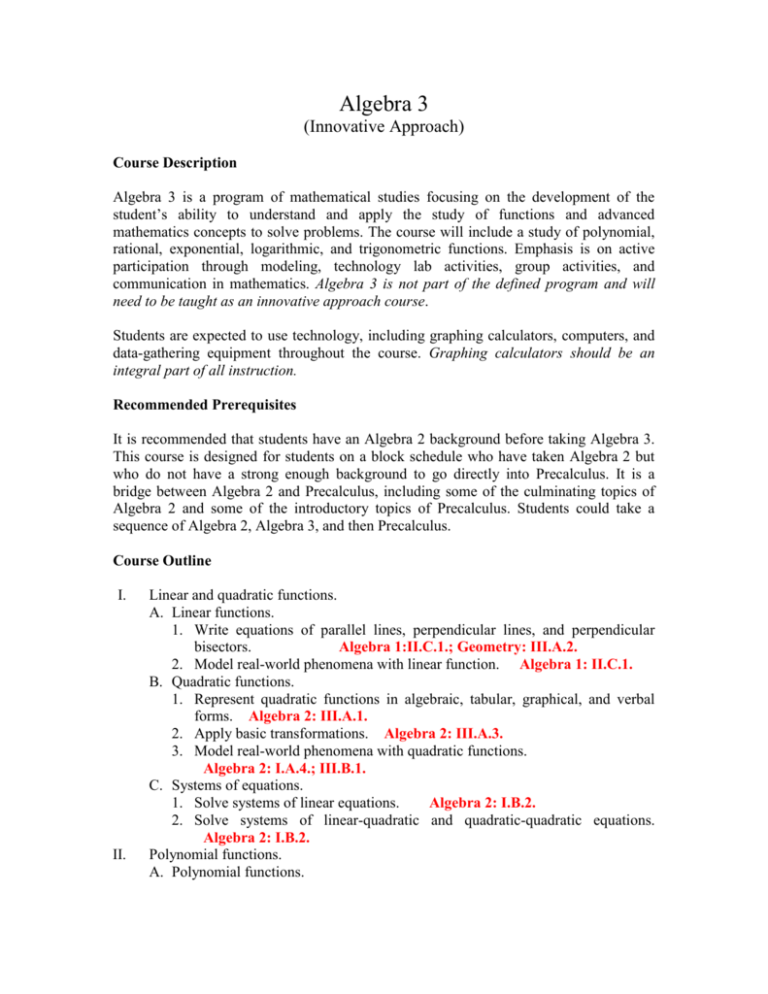
Algebra 3 (Innovative Approach) Course Description Algebra 3 is a program of mathematical studies focusing on the development of the student’s ability to understand and apply the study of functions and advanced mathematics concepts to solve problems. The course will include a study of polynomial, rational, exponential, logarithmic, and trigonometric functions. Emphasis is on active participation through modeling, technology lab activities, group activities, and communication in mathematics. Algebra 3 is not part of the defined program and will need to be taught as an innovative approach course. Students are expected to use technology, including graphing calculators, computers, and data-gathering equipment throughout the course. Graphing calculators should be an integral part of all instruction. Recommended Prerequisites It is recommended that students have an Algebra 2 background before taking Algebra 3. This course is designed for students on a block schedule who have taken Algebra 2 but who do not have a strong enough background to go directly into Precalculus. It is a bridge between Algebra 2 and Precalculus, including some of the culminating topics of Algebra 2 and some of the introductory topics of Precalculus. Students could take a sequence of Algebra 2, Algebra 3, and then Precalculus. Course Outline I. II. Linear and quadratic functions. A. Linear functions. 1. Write equations of parallel lines, perpendicular lines, and perpendicular bisectors. Algebra 1:II.C.1.; Geometry: III.A.2. 2. Model real-world phenomena with linear function. Algebra 1: II.C.1. B. Quadratic functions. 1. Represent quadratic functions in algebraic, tabular, graphical, and verbal forms. Algebra 2: III.A.1. 2. Apply basic transformations. Algebra 2: III.A.3. 3. Model real-world phenomena with quadratic functions. Algebra 2: I.A.4.; III.B.1. C. Systems of equations. 1. Solve systems of linear equations. Algebra 2: I.B.2. 2. Solve systems of linear-quadratic and quadratic-quadratic equations. Algebra 2: I.B.2. Polynomial functions. A. Polynomial functions. III. IV. 1. Describe the general shape of a graph and the effect of transformations on the domain and range. Precalculus: II.A.1. 2. Recognize the connections among the significant points of a function, the graph of a function, and the algebraic representation of a function. Precalculus: I.A.6. a. Roots. b. Maximum points and minimum points. 3. Investigate continuity and end behavior. Precalculus: I.A.7. 4. Solve equations and inequalities using graphs, tables, algebraic methods, and technology. Precalculus: II.A.3. B. Problem situations. 1. Analyze a verbal, graphical, or tabular representation of a polynomial function.Precalculus: II.A.2. 2. Analyze a problem situation by formulating an equation or inequality. Precalculus: II.A.4. Exponential and logarithmic functions. A. Exponential functions. 1. Describe the general shape of a graph and the effect of transformations on the domain and range. Precalculus: II.B.2. 2. Investigate asymptotic behavior. Precalculus: II.B.2. 3. Investigate exponential properties graphically and algebraically. Precalculus: II.B.2., 5. 4. Solve exponential equations and inequalities using graphs, tables, algebraic methods, and technology, and investigate the reasonableness of solutions. Precalculus: II.B.4. 5. Model real-world phenomena with exponential functions. Precalculus: II.B.5., 6. B. Logarithmic functions. 1. Describe the general shape of a graph and the effect of transformations on the domain and range. Precalculus: I.B.1.; II.B.2. 2. Develop the connection between exponential and logarithmic functions. Precalculus: II.B.1. 3. Investigate asymptotic behavior. Precalculus: II.B.2. 4. Investigate logarithmic properties graphically and algebraically. Precalculus: I.B.3.; II.B.7 5. Solve logarithmic equations and inequalities using graphs, tables, algebraic methods, and technology, and investigate the reasonableness of solutions. Precalculus: II.B.4. C. Problem situations. 1. Analyze a verbal, graphical, or tabular representation of an exponential or logarithmic function. Precalculus: II.B.5. 2. Analyze a problem situation by formulating an equation or inequality. Precalculus: II.B.5. 3. Model real-world phenomena with logarithmic functions. Precalculus: II.B.5., 6. Conic sections. V. A. Conic sections. 1. Identify the graph of a conic section from its algebraic equation. Algebra 2: II.B.3. 2. Graph a conic section including translations. Precalculus: III.B.3. B. Problem situations. 1. Model real-world phenomena with conic sections. Precalculus: III.B.1., 2. 2. Solve systems of second-degree equations that model real-world phenomena. Algebra 2: I.B.2. Trigonometric functions. A. Triangle trigonometry. 1. Evaluate all six trigonometric functions using a right triangle. Precalculus: I.A.4. 2. Solve problems using the law of sines and the law of cosines. Precalculus: II.C.3. 3. Find the area of a triangle. Precalculus: II.C.3. B. Problem situations. 1. Analyze a verbal, graphical, or tabular representation of a trigonometric function.Precalculus: II.B.7. 2. Analyze a problem situation by formulating an equation or inequality. Precalculus: II.C.1., 2. 3. Analyze graphical data gathered by technical equipment. Precalculus: II.B.7.
